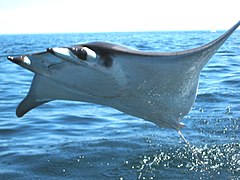

| Mobula
Early Oligocene to present[1] | |
|---|---|

| |
| Mobula sp breaching, Baja California | |
| Scientific classification | |
| Domain: | Eukaryota |
| Kingdom: | Animalia |
| Phylum: | Chordata |
| Class: | Chondrichthyes |
| Subclass: | Elasmobranchii |
| Superorder: | Batoidea |
| Order: | Myliobatiformes |
| Family: | Mobulidae |
| Genus: | Mobula Rafinesque, 1810 |
| Type species | |
| Raja mobular Bonnaterre, 1788 | |
Mobula is a genus of rays in the family Mobulidae that is found worldwide in tropical and warm, temperate seas.[3] Some authorities consider this to be a subfamily of the Myliobatidae (eagle rays).[4][5] Their appearance is similar to that of manta rays, which are in the same family, and based on genetic and morphological evidence, the mantas belong in Mobula (they are traditionally in their own genus Manta).[3]
Species of this genus are often collectively referred to as "devil rays", "flying mobula", or simply "flying rays", due to their propensity for breaching, sometimes in a spectacular manner. These rays gather in groups and leap out of the surface into the air up to around two metres before splashing back into the water.[6]
| External videos | |
|---|---|
Depending on the species, the devil rays can attain widths up to 1.1–5.2 m (3.6–17.1 ft), the largest being second only to the manta rays in size, which can reach 5.5–7.0 m (18.0–23.0 ft).[3] Despite their size, little is known about the devil rays, much of it anecdotal; the manta rays are better known.
Most species entirely lack a tail stinger. In most species having a stinger, it is encased, rendering it harmless; only M. mobular has a "free" stinger.[3]
The genus is named by Constantine Samuel Rafinesque in 1810 describing the devil fish, Raia mobular or now Mobula mobular. The name can be explained from Latin mobilis "mobile" or "movable", because of the species' migratory habits;[7][8] another explanation is that mobula is a local name used by people living in Azores who call this creature there.[7]
Based on genetics and, to a lesser degree, morphological evidence, the genus was redefined in 2017. Under this arrangement, Manta is included in Mobula.[3]
FishBase recognizes 11 species:[5]
Extinct species by Shark-References:[9]